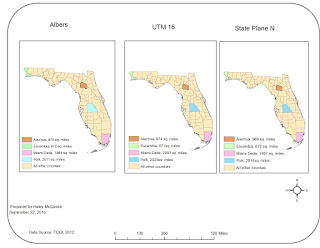Module #4 - Ground Truthing and Accuracy
The BLOG postings for Module 4 illustrated that a number of students, including Sara Rehrer and Matt Griggs, had a high level of understanding of sampling design for ground truthing and accuracy assessments of Land Use Land Cover (LULC) images. However, we thought Melissa Thrush's BLOG posting was especially good.
The goal(s) for this BLOG post were:
- Construct an unbiased sampling system
- Locate and identify features using Google Maps street view
- Calculate the accuracy of a Land Use / Land Cover classification map
Mr. Brian Fulfrost, the instructor for this course states that he chose Melissa because her BLOG posting provides both an excellent overview of the the steps (and logic) one would take to choose a systematic sampling design as well as a good description of the accuracy assessment process itself and her final results. The BLOG also includes details about potential issues she identified in the accuracy assessment process - specifically the role that mixed land use/cover can have on accuracy. In addition to her knowledge of using ArcGIS to generate the sampling points and make her final map, she seamlessly used Google Maps street view to evaluate the Land Use Land Cover (LULC) at the sampling point locations she created. Melissa also correctly identified the role that taxonomic scale of the LULC classification (Level I, II, II, etc.) can have have not only on the level of detail but also the accuracy assessment itself. What impressed me the most was that Melissa's BLOG post also demonstrates her ability to learn and build off of techniques and concepts from previous modules - in this case the role that an inconsistent Minimum Mapping Unit (MMU) might have also had on her accuracy assessment. It is the ability to connect concepts and techniques from one module to another and then communicate that "lesson learned" that made Melissa's BLOG stand out. Her final map also does a very good job communicating her results - it is well designed and easy to read. Overall, Melissa's BLOG posting was very good!
Follow Melissa's progress at her student blog:
http://melissathrush.blogspot.com


